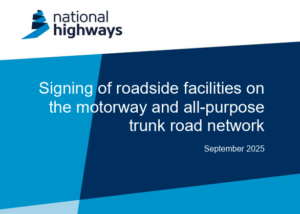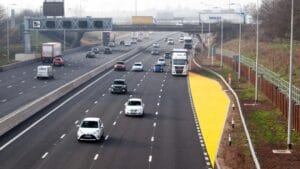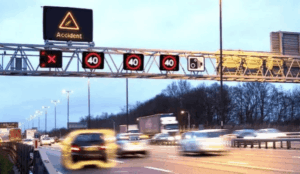Transport Secretary, Grant Shapps, has asked the Office of Rail and Road to confirm the evidence base for the ‘relative safety’ of All Lane Running (ALR) motorways.
The move comes after Mr Shapps spoke to the House of Commons yesterday following the publication of Highways England’s smart motorway stocktake first year progress report. The report contains the latest safety data which updates analysis contained in the 2020 Stocktake report. At the same time, it was confirmed by the Department for Transport (DfT) that measures to boost safety on all lane running motorways is to be accelerated.
In a letter to John Larkinson, Chief Executive Officer, Office of Rail and Road, Mr Shapps asked for the scope of the independent review to focus on quality assurance of all lane running motorway data and evidence. He said that on provision of relevant data and evidence from Highways England and the Department for Transport, the ORR has been asked to address the questions that includes whether the data and evidence used in the stocktake and the progress report reliable and robust and in line with established/best practice? It asks whether comparisons been made in an appropriate way about the relative safety of ALR motorways, with reference to conventional motorways and other roads, and also if there is other data that could be used to enhance the understanding of the relative safety of ALR motorways, or to support the monitoring and evaluation of the effectiveness of the measures that DfT is putting in place to improve safety and perceptions of safety?
Mr Shapps has asked for a full report to be issued by 28 June.
“As you know, since becoming Secretary of State for Transport, I have heard concerns expressed by the public and key stakeholders about the safety of ALR motorways. One of my first actions as Secretary of State was to commission an evidence stocktake. This concluded that “Overall, what the evidence shows is that in most ways, smart motorways are as safe as, or safer than, the conventional ones. But not in every way,” he said in his letter to the ORR.
“I believe it is critical that the public, stakeholders, and the media are confident about the data and evidence we have about the safety of our roads. I am also conscious that making comparisons about the relative safety of different road types using different types of data and evidence is a complex area. That is why I have decided to ask for some quality assurance of the information we have and the conclusions we are drawing from it.”
Earlier in his statement to the House of Commons, Mr Shapps said Highways England’s smart motorway stocktake first year progress report demonstrated ‘significant progress’ against the 18 actions, which when delivered in full, ‘will raise the bar on motorway safety’.
Last March the Department of Transport published a Smart motorway safety evidence stocktake and action plan. The safety improvements in the 2020 action plan consisted of a package of 18 actions, costing £500 million, including the rollout of radar-based stopped vehicle detection (SVD) technology across the All Lane Running (ALR) motorway network and an additional £5 million on national and targeted communications campaigns to ensure drivers receive advice to help them keep safe.
The law has also been changed to enable automatic detection of vehicles driving in closed lanes, known as red X violations. Highways England is also upgrading all enforcement cameras across the smart motorway network to enable automatic detection of red X violations which can then be enforced by the police.
In his statement Mr Shapps said Highways England is now ‘accelerating’ a number of actions so that the completion dates set out in Highways England: Strategic Business Plan 2020-25 are brought forward. “Most significantly, radar-based stopped vehicle detection technology will now be installed on all operational ALR motorways by September 2022, six months earlier than planned, “ he said.
“Highways England has also made a commitment that no ALR motorways will open without radar technology to spot stopped vehicles, enable lanes to be closed where necessary and get help to drivers quickly,” he added.
The data contained in the Highways England progress report continues to show that fatal casualties are less likely on all lane running motorways than on conventional ones, but we know drivers can feel less safe on roads without hard shoulders, which is why the progress report, published today, intends to accelerate a number of actions to provide reassurance to drivers, said Mr Shapps.
Meanwhile, it was also confirmed by the DfT that every new All Lane Running (ALR) motorway will open with radar technology in place to spot stopped or broken-down vehicles quickly. All existing ALR motorways will have the technology fitted six months earlier than originally planned.
To accelerate improvements, by the end of September 2022, Highways England will implement a number of measures including the installation of radar technology on all existing stretches of ALR motorway.
It will also work to update the Highway Code to provide more guidance about driving on ALR motorways will also be bought forward and is due to be published this year, ahead of schedule.
Data from the progress report, covering the five years from 2015 to 2019 inclusive, shows that ALR motorways are one of the safest types of road in the country. Drivers on a conventional motorway are 33% more likely to be involved in a fatal accident than drivers on an ALR motorway. The data also demonstrates that the fatality rate on strategic road network A roads is three and a half times that on ALR motorways, said the DfT, It said that the figures have been compiled on a five-year basis because single-year figures are too low, and fluctuate too much to draw conclusions from. For the year 2019, there were nine fatalities on ALR motorways, one less than in 2018, and a total of 15 fatalities on motorways without a permanent hard shoulder, four more than in 2018.
The increase in fatalities in 2019, it said, was accounted for by so-called ‘Dynamic Hard Shoulder’ motorways, where the hard shoulder operates only part-time. All these motorways are being withdrawn and replaced with ALR motorways.
Mr Shapps added: “Despite the data showing that fatalities are less likely on All Lane Running motorways than on conventional ones, this doesn’t mean all drivers necessarily feel safe on them.
“That is why I tasked Highways England last year with delivering an action plan to raise the bar on safety measures even higher. This progress report shows the extensive work already carried out, but we want to do more. Alongside the raft of measures already undertaken, today I am announcing that all new All Lane Running motorways will open with stopped vehicle detection technology in place, as well as a programme to speed up the roll-out of the technology on previously built stretches of All Lane Running motorways to next year. This will help us further reduce the risk of accidents on the country’s roads. So-called smart motorways started to be built in 2001 and I am determined to ensure that technology and exacting standards are in place.”
HE’s Stoktake progress report can be read in full here: Smart motorways stocktake, First year progress report 2021 (highwaysengland.co.uk)
Grant Shapps’ letter to the ORR can be read in full here: Letter to ORR from the Secretary of State: Quality Assurance ALR Data (publishing.service.gov.uk)
Grant Shapps’ statement to the House of Commons can be read in full here: Highways England first year progress report on smart motorways stocktake – GOV.UK (www.gov.uk)






















